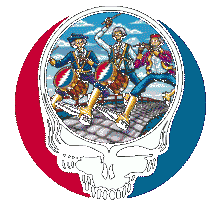Not Dead Yet

From the Crusader:
By Chris Charles
In the pantheon of rock and roll, there exist but a few artists whose name elicits universal respect and admiration: Robert Johnson, The Beatles and Jimi Hendrix are among them. Their work transcends time, capturing a moment of raw human emotion and sentiment and transcribing it on a piece of vinyl. The true measure of the greatness of these musicians lies in their ability to forever alter the course of one's art form. Simply rehashing the styles and techniques of one's predecessors is not enough; rather, in order to be considered one of the elite artists, one must draw upon influences while simultaneously synthesizing a new and daring vision for the future.While most fans of music can rattle off a string of Rolling Stones' hits and flawlessly mimic Jimmy Page's searing guitar riffs, few would mention the Grateful Dead in the same breath as these legendary artists. Beyond one or two "commercially friendly" songs, the Dead's cache of work remains largely unknown to a vast portion of the population. Yet to those who consider themselves "Dead Heads," the band garners an intense devotion unrivaled among any other artist.The following question must subsequently be posed: What is the reason for this schism? Certainly, the Grateful Dead have a reputation of the occult and mystical. Their name is paradoxical, evoking images not typically associated with the good time generally sought by those who listen to rock music. Nevertheless, once one summons the courage to venture beyond the stereotypes associated with the Dead and their psychadelica, an entire new musical world awaits.Known primarily for their prolific touring habits and extended jamming, the Dead have their roots in nearly all forms of music, including bluegrass, country, jazz, blues and even funk. Their long, strange trip began amid the turbulence of San Francisco in the 1960's. It was within this melting pot of freedom and creativity that the original members of the band were able to explore the boundaries of their musical abilities. Jerry Garcia, Bob Weir, Ron "Pigpen" McKiernan, Bill Kreutzman and the ever-gawky Phil Lesh joined forces as "The Warlocks," an R&B cover band that played seedy, biker bars along the California coastline. While the group did not lack musical proficiency, particularly Garcia and Lesh, they did lack the unique dynamic which would later serve to distinguish them from their peers. It may be argued that whatever spark they needed to ignite the rollercoaster ride that was to become the Dead was found in the form of LSD. During Ken Kesey's infamous "Acid Tests" the quintet served as the house band for the psychedelic fiascos, often jamming uninterrupted until the break of dawn.
All the Grateful Dead really needed, however, was the freedom to explore the depth and breadth of their collective musical abilities. The band diverged from the path of a mere cover band, finding their voice in the frenzied pace of live performance. The band began released numerous studio albums in the late 60's, beginning with their self-titled debut, but none effectively captured the fervor of their stage show. As their reputation began to grow, the Dead became the prototypical touring band throughout the 1970's and 1980's, often playing in excess of 150 dates a year. For all their reputation as a psychedelic entity, shrouded in mystery, the Dead are a very accessible band, reliant heavily on melody and rhythm to drive their jams. Their vocal harmonies are extremely tight, despite the wide tonal range covered in their tunes. Garcia is undoubtedly the single most underrated rock guitarist of all-time. His mastery of the banjo during his days as a bluegrass musician gives him a unique style, running frenetically up and down the fret board at blinding speed. As musicians, the other members of the band are equally skillful. Take the time to give the Grateful Dead a chance and you too might just find yourself digging on their delightfully delicious grooves.



0 Comments:
Post a Comment
<< Home